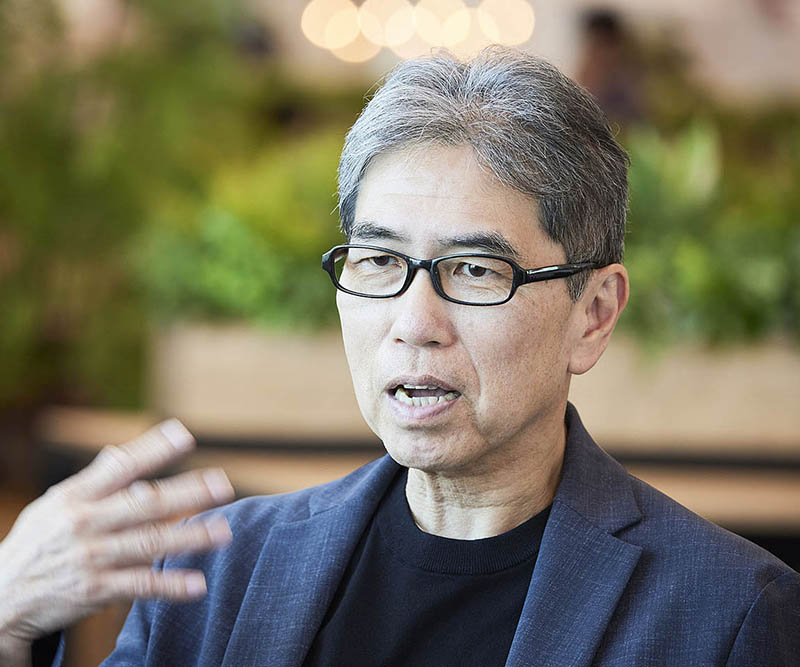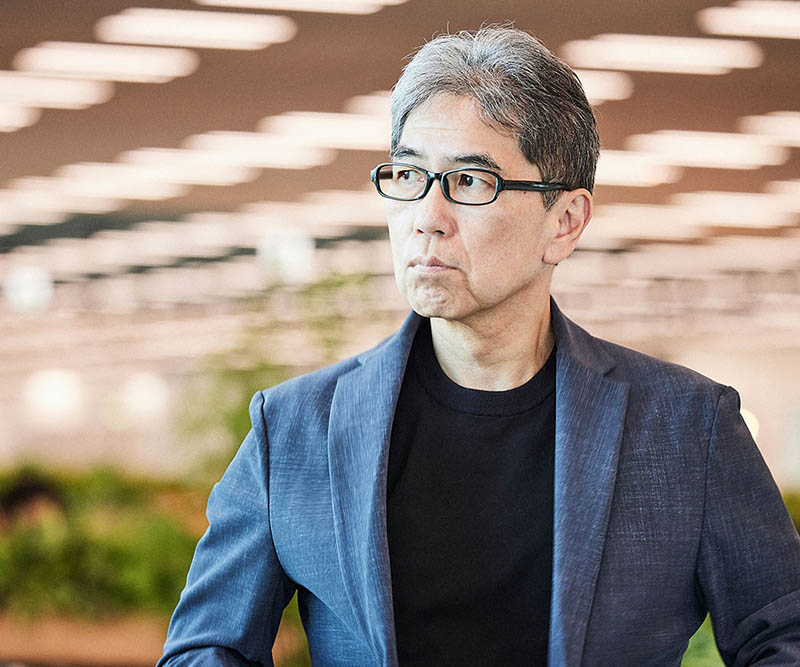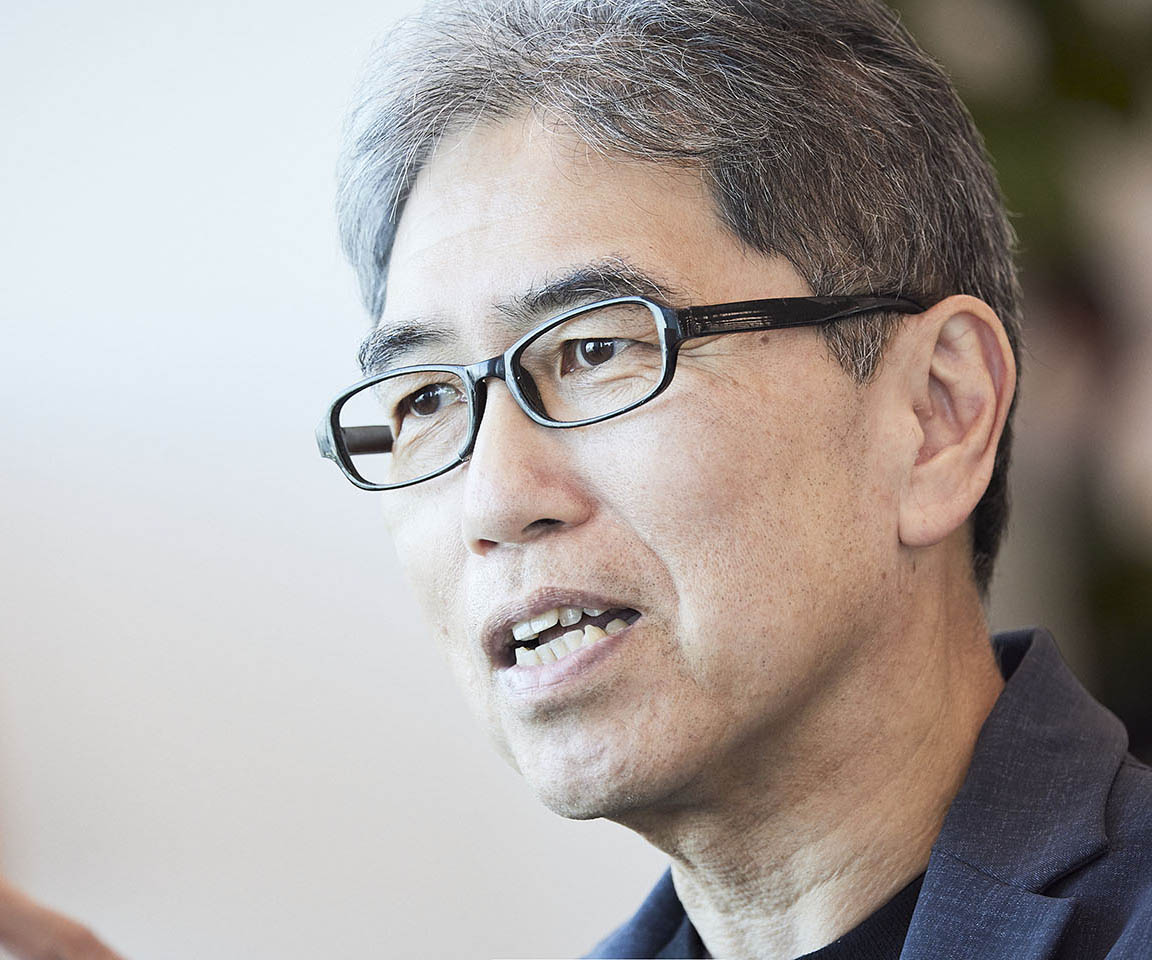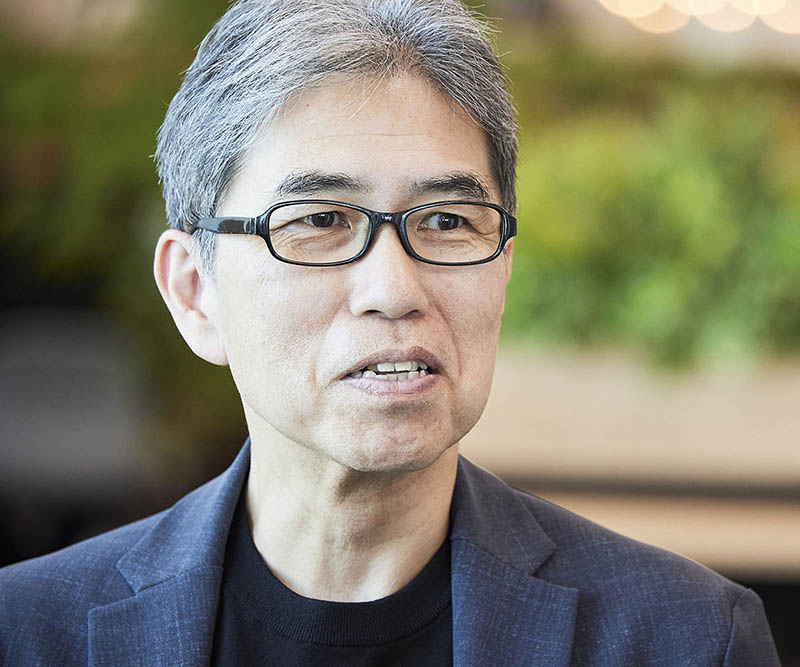Message from CEO
Transforming our people and corporate culture are the key to maximizing our corporate value
Resonac will change society and the way of Japanese corporate management
Dominance in back-end processes of semiconductor production and Cultural transformation;
Two key identities of Resonac as the driving force of our management
In January 2023, Showa Denko and Hitachi Chemical were integrated to form Resonac. Showa Denko was a raw-material company that designs going all the way back to the molecular design level. Hitachi Chemical used raw-material to create functional materials. One of the main objectives of the integration was to leverage and refine their respective strengths.
While Showa Denko excelled at raw-material technologies, Hitachi Chemical was exceptionally strong in the field of semiconductor materials, possessing 10 of the 15 materials that are vital to back-end processes of semiconductor production. Resonac combined the technologies of these two companies to turn raw-materials into highly functional materials. We own a wide range of semiconductor materials, each with the highest or second-highest market share in the global market. Resonac stands head and shoulders above its competitors because it can handle everything from raw-materials to processing, providing materials with a high level of functionality. We are able to decide on specifications directly in conjunction with the global top semiconductor manufacturers, develop materials, and then sell those materials. We are an important player in the semiconductor field, but we are not a semiconductor manufacturer, we are a functional chemical company.

Our value chain covers a large area from midstream to downstream sectors, and we have an overwhelming market share as a supplier of semiconductor materials for back-end processes. Furthermore, we have exceptionally high technological capabilities for each material. This is one of Resonac’s essential aspects, from a business portfolio perspective. In terms of profit, as well, the profit margin in selling resin used in semiconductor materials as-is, as a raw-material, is completely different from the profit margin from selling functional materials needed by semiconductor manufacturers, produced by blending resin with filler (powder). By turning raw-material into functional material, we can assure EBITDA margin of 25 to 30%.
There is another essential aspect of Resonac that I would like to emphasize: our efforts to instill our Purpose and Values throughout the Group and to foster our corporate culture.
Major, long-established Japanese companies such as former Showa Denko or former Hitachi Chemical (the kind of companies that have recently come to be called “Japanese Traditional Companies,” or “JTCs” satirically) often have extremely skilled engineers and scientists, but do not allow them to reach their full potential. To unlock that potential, companies must transform their entire cultures. We are working hard to cultivate a new corporate culture, driven by a powerful desire to urgently leave behind our past as a JTC.
Ever since I was appointed CEO, we have been creating a distinctive business portfolio and refining the transformation of our corporate culture. As CEO, I am responsible for maximizing our corporate value, and I have worked diligently to do that without wavering. But where is our Group heading? That is the next thing I would like to talk.
“This would never have been possible without Resonac”
“Resonac transformed the way of Japanese corporate Management”
Striving to be a company that is a spearhead for change
Resonac’s Purpose is to “change society through the power of chemistry.” I truly want to change society. I have two conceptual goals I would like us to achieve. The first is that, when something becomes popular decades from now, I want people to be saying “This would never have been possible without Resonac.”
For example, AI is poised to change society in major ways. To enable semiconductor packages for AI applications to rapidly process high volumes of information, it will be essential to place both logic and memory on a single substrate, or to stack up chips in 2.xD or 3D integrated packages. This will require material innovation, as well. Semiconductor manufacturers are competing against each other to achieve new package advances. We are already supplying three new materials that contribute to the evolution of these packages, and we enjoy the top market share worldwide. We have also made progress on the development of another promising material. Package materials are one of the areas in which Resonac particularly excels, and we can contribute to the evolution of AI in each manufacturer through our materials. It is like we have the same impact as Shohei Ohtani, whom every Major League team was vying to sign. If we keep contributing in this way, I believe that my dream, where people decades from now say “the great AI transformation would never have been possible without Resonac,” will be an attainable one. Furthermore, as we are not a semiconductor manufacturer but a functional chemical company, even if something new and totally different from semiconductors takes the world by storm, we can provide functional materials for that. The power of chemistry is at the heart of every industry, so the range of fields where we can make people say “It would never have been possible without Resonac” is limitless. What is more, we have the combined R&D and technical strengths of Showa Denko and Hitachi Chemical, and at our Stage for Co-creation open innovation site, we are using computational science methods to develop state-of-the-art technologies. I am confident that Resonac will change society through the power of chemistry.
My other goal is for people to say “The rise of Resonac transformed the way of Japanese company management.” I want to present the world with innovation so great that people think in terms of “before Resonac” and “after Resonac.” The approach I believe we should use to achieve this is to take on the challenges of transforming JTCs. As I touched on earlier, companies must unleash employees to express their full potential. At the same time, employees must be able to act autonomously. We must continue to develop wonderful products and services, but we must go beyond that to show the world the potential of our employees. If we can create such an environment, I am confident that the management of Japanese companies will change. This may be an experiment of massive scale, but with Resonac, I would like to show the world an actual example of how JTC culture can be revolutionized.
-These are my conceptual goals for how Resonac can change society. I believe that working towards these conceptual goals will also contribute to the maximization of Resonac’s corporate value.
“Corporate Value = Strategy x Individual abilities x Corporate Culture”
Striving to raise the level of these three elements
I believe that corporate value is the synergistic product of strategy, employee’s individual abilities, and corporate culture. The only way to maximize corporate value is to take these elements to the next level. Unfortunately, not all three of these have been raised to the needed level, so we are in the process of addressing them, one by one. I would like to explain what we are doing to elevate the levels of each of these elements ? that is, what specific measures we are implementing to maximize corporate value.
1. Building strategies for acquiring greater market share through semiconductor materials business
First, I will discuss our strategies. Our strategy for maximizing corporate value is extremely simple: become a World-class Functional Chemical Company.
To do this, we will reshape our business portfolio from the three perspectives of (1) whether the business is a good fit for Resonac’s strategy, (2) whether the profitability meets Resonac’s minimum profitability requirements, and (3) whether Resonac is the best owner for the business.
Of course, our business portfolio ideals will change with the changing demands of the world at large. Large-scale investment can lead to overestimation of unidentified risks, leading to hesitation. We need to believe in our current ideals, based on the three perspectives I mentioned earlier, and take that first step forward without delay. In other words, I believe it is important to actively invest in necessary businesses and peripheral technologies if we are to maintain sufficient mass within the semiconductor materials sector.

Until now, semiconductor performance improvements have been reliant on miniaturization in front-end processes. However, the limits of miniaturization are within sight. There is a trend of seeking greater cost performance by creating larger substrates or multi-layer substrates in back-end processes, or in connecting substrates laterally. More attention than ever is being focused on back-end processes. We have a dominant market share in this area, so we have the foundation from which we can create a greater presence. I believe we must use this as a tailwind and take advantage of this for further growth.
Our core competence in the semiconductor materials business lies in development. We especially focuse on appropriately and continuously hiring and developing R&D talents. To deal with geopolitical risks, we are also building a basic database related to our supply chain.
The Packaging Solution Center, our development site in Kawasaki, has the latest semiconductor manufacturing equipment. Through the JOINT2 consortium we established there, we are working with manufacturers of semiconductor manufacturing equipment, materials, and substrates to take on the challenges of developing new technologies. Furthermore, we will open a second consortium in Silicon Valley, U.S. We want to increase Resonac’s presence and level of activity in the U.S., and we believe that it will be important to leverage the advantages of our site’s location in Silicon Valley to strengthen our relationships with GAFAM and others. In recent years, major semiconductor manufacturers, fabless companies such as GAFAM, and major IT companies clustered in Silicon Valley have started designing their own semiconductors. They need sites with which they can engage in close discussions regarding their concepts, and where they can perform proofs of concept. We cannot afford to be behindhand in developments in the world of AI.
For a company such as our own, which has a wide range of business segments, minimizing conglomerate discounts is a critical business issue. Our Long-Term Vision of becoming a World-class Functional Chemical Company tackles this issue by closing the chapter of our history in which we are a comprehensive chemical manufacturer and by building a business portfolio specializing in functional chemicals.
In the process of deliberating the reshaping of our business portfolio based on this strategy, last February we announced that we were considering a partial spinoff of our petrochemical business. The petrochemical business produces few derivatives, and we have achieved little success in connecting it with our monomer production. In that sense, I’m afraid that Resonac is not the best owner of this business, but at the same time we must consider the happiness of our employees. Resonac is finally breaking away from the JTCs, and we have just started working together to carry out transformation. Simply transferring the business to or partnering with another company would be against the cause. The solution we came up with after much struggle was the partial spinoff approach. We would remain connected as a single community while eliminating conglomerate discounting. We would not be publicly listed parent/subsidiary pairs, but the strengths of each business could be leveraged to their fullest. I think this makes it a wonderful solution. This would also benefit shareholders and enable us to achieve the overarching goal of independence for the petrochemical business. That said, there is still room for additional tweaking, so we need to think further about the specific details.
2. Improving engagement to unleash our people’s individual abilities and foster their autonomy
Next, I would like to talk about employee’s individual abilities. When it comes to individual abilities, I think it is important that Resonac be a company in which the employees can enjoy their work.
As I have often discussed, a CEO’s job is to maximize corporate value. Improving the numbers on financial statements is, of course, vital, but this can only be achieved if each and every person in each business unit works hard. That is why I dedicate so much time and effort to improving employee engagement. Just sitting in a chair in the President’s office, brows furrowed, trying to fire people up over the phone?that will not change the numbers on financial statements. If you work upstream, thinking about what kinds of management measures should be implemented, and what needs to be done in order to implement those measures, you eventually get to improving employee engagement. This is the challenge at the heart of maximizing corporate value. Instead of using stopgap measures to boost revenue, it is ultimately more effective to focus on the root of the matter. That is what a CEO should do, and it is what I can do precisely because I am the CEO.
In the first year after the integration, I thoroughly communicated my ideas and approach throughout the company. I met with over 1,000 employees over the course of the year in town-hall meetings and roundtable discussions, in which I discussed our Purpose and Values. We had a lot of feedback that employees wanted two-way communications with management, so in the second year we started holding “Moyamoya Meetings.” This program gathered junior employees to share their moyamoya (frustrations) and to engage in discussions with management about potential ways to use Value to solve these problems. Frustrations can provide insights and can resonate with others, and the process of searching for solutions is a small-scale example of co-creation.
Now, in our third year, employees have a base understanding of our Purpose and Values, and our culture of co-creation is beginning to take root. The next thing we wanted to do is to have employees take a good look at themselves, so we began holding our “Purpose Exploration Cafe.” During these sessions, employees reflect on their past, examine their present state, and talk about their future ideals.

At the end of these sessions, we ask them, “What is your purpose?” This question is asked to prompt participants to look inward and realize that their happiness lies in their purposes. Participants look objectively at the relationship between their own purposes and that of Resonac. What I tell them there is that Resonac is the vehicle by which they can achieve their own purposes, so I want them think of how they can use Resonac. I want our employees to be autonomous, not reliant on the company. The working styles and ways of thinking of the autonomous employees produced by these initiatives will affect many others within their workplaces.
In this way, through a series of stages, we have been developing autonomous, co-creative talent that embodies our Purpose and Values. We examine how established our Purpose and Values have become among employees through the engagement survey we conduct each year. The percentage of respondents indicating that they put our Purpose and Values into practice has increased significantly. I believe we are steadily approaching our goal of becoming a company that develops co-creative talent that represents Japan’s manufacturing industry.
3. Accelerating co-creative innovation by reforming our corporate culture
With regard to the third element of corporate value, corporate culture, transforming corporate culture is an area that we have devoted special attention to, alongside people development.
No matter how we may try to promote our Purpose and Values, they will not become truly established if executives take the initiative. That is because when higher-ups change, movements come to a standstill. To institutionalize these changes, we must foster a corporate culture that spontaneously produces co-creative talent. Combining co-creative talent and cultural transformation will accelerate co-creative innovation.
For Resonac, producing synergy between Showa Denko and Hitachi Chemical is a vital challenge. For example, so far, the synergy we have produced has been limited to topical efforts, such as one site developing powder upon request from another site that manufactures semiconductor materials. We are trying to connect such synergies to produce comprehensive synergy. We are reallocating powder development scientist to sites that make materials. We are trying to produce a chemical reaction, but by mixing people, not chemicals.
The next issue will be where to place our center-of-excellence functions. We are planning to set up separate R&D sites for raw-materials and technologies such as powders, resins, and monomers. This will take us beyond mere synergy to producing true co-creative innovation.
Furthermore, we are starting to see self-directed moves connecting marketing to development. For example, from the starting point of “what kinds of materials are necessary for 6G,” we are thinking about the material properties that are needed for 6G applications and deciding which center of excellence would be the best choice for them. Such a trend is actually beginning to emerge.
There have also been some interesting movements by the Research Center for Computational Science and Informatics. The Research Center for Computational Science and Informatics brings together exceptional people. It uses computational science to perform, for example, 100 parallel simulations instead of 100 separate experiments, as would otherwise be necessary. It then selects the simulation with the most promising results. A single experiment using the most promising parameters suffices, instead of performing 100 different experiments. This can dramatically reduce development times. This is a true game changer. The Center’s exceptional talents also takes the initiative, going to various worksites and asking if there are any simulations they would like carried out. The resources belonging to the Research Center for Computational Science and Informatics, which were originally used by former Showa Denko, have been reassigned to former Hitachi Chemical’s semiconductor materials field, and that is where the Center currently focuses its support. I am really looking forward to seeing what kinds of results this approach will generate.
All kinds of business sites are proactively launching activities such as these, which embody our Purpose and Values. Taking concrete action also accelerates the transformation of our culture. However, I think of the transformation of our corporate culture as a decade-long project. That is why even after I step down as CEO, this transformation of our corporate culture must maintain a steady course. I am communicating closely with the Nomination Advisory Committee about selecting a successor who will carry on this Purpose and Value management, or perhaps extending my own term of office somewhat. This will be a long battle, but our people and our corporate culture are at the heart of our maximization of corporate value, so we will keep working on them, steadily and diligently.
Unswerving “resolve and conviction” Steadfast dedication to “Cause and Dignity”
In my leadership, I strive to achieve both
As I have said countless times, a CEO’s job is to maximize corporate value. As part of my efforts to do so, I have been working to raise our percentage of long-term shareholders. Twice each year, I visit long-only investors in Europe and the U.S. and urge them to invest in Resonac. I believe that one of the reasons that our stock price has been relatively solid is that we have increased the number of these long-term investors.
When long-only investors make investment decisions, they look at (1) whether or not they can trust top management’s abilities, (2) whether the company is living up to its promises, and (3) the company’s track record. Investors understand my commitment to maximizing corporate value, so it would appear that we have met criteria (1) and (2). Investors often ask me, “You are not going to quit, are you?” They believe in my resolve and conviction when it comes to maximizing corporate value, and I think that is what they are betting on.

That resolve and conviction are unswerving, but I also often talk about our need for unsullied cause and dignity to maximize corporate value. It is difficult to maintain resolve and conviction while also maintaining greater good and dignity. If all we were after was maximizing corporate value, the best choice might, for example, be to fully spin off our petrochemical business. But that is the approach of a capitalist, and I am a corporate manager. No matter what happens, I do not want us to abandon our cause and dignity.
With respect to the third point that long-only investors focus on, a company’s track record, we are expecting to show solid numbers this year. I have started my third tour of our business sites around the world, talking directly to employees, and I can feel how the atmosphere at the sites has changed. I can see a difference in the expressions on the faces of employees at the sites. Seeing these changes, I am confident that we are building an even more solid track record. I assure you: you can look forward to seeing some great results in the future.
Lastly, let me speak a little about why I feel so confident about the future. It is because I have experienced the business transformation that is essential for maximizing corporate value, and I can conceptualize our goals. There are not that many corporate managers with a clear image of their goals.
My goal is a company in which we share the same values, working in an environment with just the right level of competition. One in which teams work together to achieve their goals. A company that feels wonderful to be a part of. A company that provides an overwhelming feeling of accomplishment. My goal is for every employee to experience this. The feeling of accomplishment I experienced while at GE* may responsible for my strength as a corporate manager. I think it would be wonderful if we could all experience forming teams to work towards our goals?if teams defined their own goals based on values shared by all of their members. Wouldn’t that be a wonderful company? I am doing my utmost to make that a reality for Resonac.
- *GE: GE Japan Holding Corporation
Hidehito Takahashi
President and CEO
